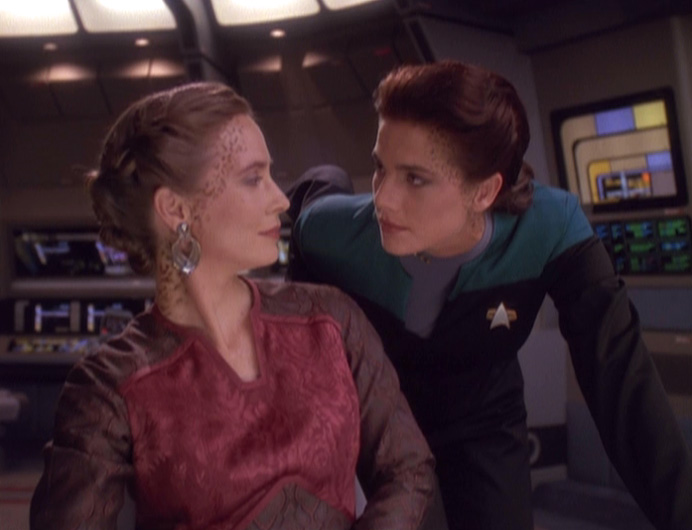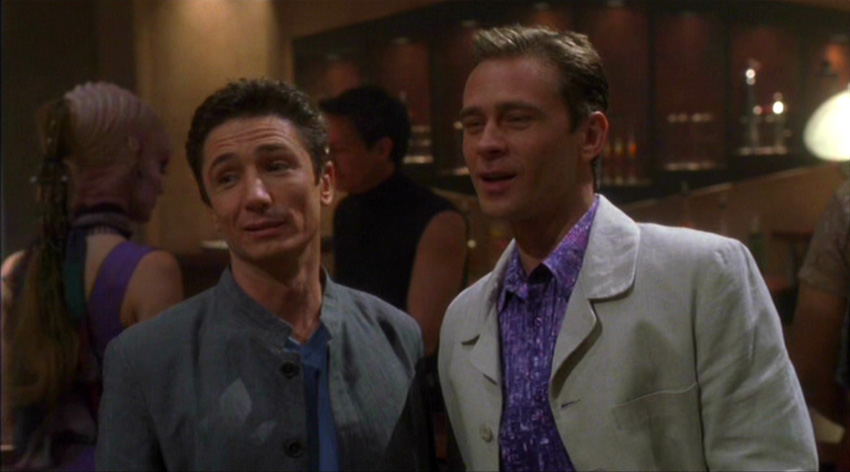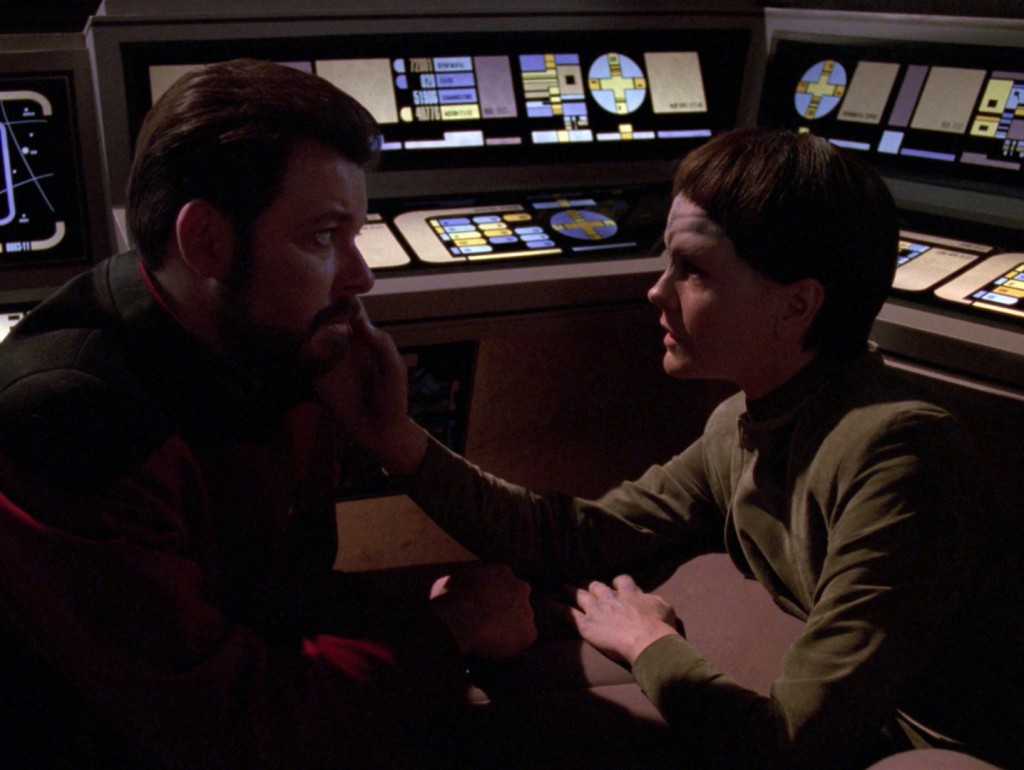Star Trek is an enormous and complex cultural entity whose impact on politics, technology, and storytelling are undeniable. It’s also as flawed and problematic as any other massive media franchise. Lifelong Trekkie and Deadshirt Editor-in-Chief Dylan Roth attempts to make sense of it all for die-hards and outsiders alike in his monthly column: Infinite Diversity.
“‘Tell me why there are no gay characters in Star Trek.’ This is one of those uncomfortable questions I [hated] getting when I was working on the show, because there is no good answer for it. There is no answer for it other than people in charge don’t want gay characters in Star Trek, period.”
– Ronald D. Moore, writer and producer on Star Trek: The Next Generation, Deep Space Nine, and Voyager, in a 2000 interview with the now-defunct Fandom.com
From the outset, I had two central goals for Infinite Diversity: first, I wanted to create an accessible window through which non-fans of Star Trek could approach the material, since Trek and Trek fandom are so massive and intimidating. Second, I wanted to go in depth into the themes and messages of the franchise, and to determine how well the writers make their points from the perspective of a modern progressive viewer. Star Trek is a formative part of my development as a person, and somewhat like a religious person examining their faith, I want to challenge the lessons that Star Trek taught me as a young person.
I had a checklist of social and political issues I planned to examine in the column, and I was confident in my ability to fairly analyze each one, even if the issue in question was beyond my own personal experience as a straight, white, cisgender male from the suburban United States. This is a particularly thin tightrope to walk, especially when discussing Star Trek‘s sticky attitudes on racial identity or sexual exploitation. It is, perhaps, presumptuous for me to attempt to tackle these issues from my position of privilege, but I always make certain to consult with other writers and editors with more relevant experience to ensure that I offer a degree of authenticity. So far I believe I have been successful in this effort.
I put off writing about queerness in Star Trek for a while, partly because I didn’t want to burn through all the hot material in the first couple of months, and partly because, to be honest, I knew it was going to be difficult. There are a lot of angles to consider in this particular story—representation of characters, treatment of homosexuality and transgender as “issues,” the franchise’s failure to fulfill their promises to their LBGTQ fans—and I don’t have a background in gender studies or queer criticism. But I wrote up a draft of the piece and, as always, I put it in front of someone more qualified to get her thoughts. My friend and colleague Jen was able to poke a number of holes into the Trek stories in question, and a few into my own arguments as well. It was extremely helpful. In fact, it made me convinced that the architects of Trek had never bothered to have such a conversation, and their work suffered for it.
My conversation with Jen came about at around the same time as J.A. Micheline’s review of Strange Fruit over at Women Write About Comics. For those of you outside of the comics world, Strange Fruit is a story centered around black characters in the Jim Crow South, written and drawn by two white men. In her review, Micheline goes into detail about why the first issue of Strange Fruit is a failure in both concept and execution, but the Cliff’s Notes version is this: Strange Fruit is just another in a long line of attempts by white storytellers to craft a story about racism without the slightest regard for black audiences. This convinced me to further reassess the analysis in my column, and the purpose of the column itself.
Star Trek is, and always has been, a product created primarily by straight white progressives, most of them men. While there are many great Star Trek stories about injustice and inequality, most of them suffer from a kind of myopia from being conceived and executed by people of privilege, rather than by the disadvantaged. This is particularly glaring when considering the franchise’s half measures concerning homosexuality.
A Legacy of Cowardice
The most obvious sign that Trek isn’t really concerned with representing LGBTQ people is the total lack of gay or lesbian characters in the franchise. (There are a few characters here or there that could arguably be considered bisexual or transgender, but it’s always muddled in some sci-fi technicality.) It’s not at all unusual for a major Hollywood franchise to be entirely lacking in sexual diversity. (The Marvel Cinematic Universe, for example, has a single, extremely dubious example that’s only in a short film.) This on its own is unacceptable, but for Star Trek, an entity that made its bones by challenging conservative cultural norms and fighting the network to represent a multi-racial cast during the height of the civil rights movement, it’s downright unforgivable.
The thing is, members of the Star Trek creative team have repeatedly toyed with, or even promised to introduce gay characters into each new series since The Next Generation. In 1987, during the early days of TNG, Gene Roddenberry told a crowd of fans at a convention that there would be gay characters on the new show. Excited by this announcement, longtime Trek writer David Gerrold penned a script to an episode called “Blood and Fire,” which both introduced a same-sex couple aboard the ship and attempted to present a sci-fi allegory for the rampant AIDS epidemic. Not only was the episode not produced, but the internal conflict led to Gerrold (a gay man himself) leaving Trek for good. Gerrold eventually adapted and directed the episode for the fan series Star Trek: Phase Two.
In 1991, Roddenberry told The Humanist magazine that the following season would introduce gay characters to Star Trek. Roddenberry died months later, and any plans (if there were any plans) for a gay character were scrapped. While several writers, producers, and stars have stated publicly that they lobbied for the inclusion of gay characters on Star Trek, but that it was nixed by a higher-up, presumably Executive Producer Rick Berman, who was the man at the top of Star Trek‘s chain of command from 1991 through 2005.
There’s a pattern that’s repeated over and over since ’87. There are prevalent rumors that TNG‘s Geordi La Forge was originally going to be gay, but that the idea was abandoned. There is enormous gay subtext between DS9‘s Doctor Bashir and Garak, but ultimately both characters ended up with female love interests. Voyager‘s Harry Kim actually makes much more sense as a character if you assume that he’s in the closet, although the implication that anyone would need or desire to hide their sexuality in the 24th Century actually makes the whole situation worse. Enterprise‘s Malcolm Reed was going to be gay, and actor Dominic Keating was totally on board, but by the end of the first season he was flirting with women and nothing ever came of it.
Star Trek‘s failure to present homosexuals as a part of its idealistic future progressed from lazy to embarrassing to just plain offensive.
(It should also be noted that, to the extent of my research, there has never been a serious discussion of including a transgender or non-binary character in the main cast. Hell, DS9‘s Odo is a literal pile of goo, but he still identifies as male and ends up with a woman.)
Sci-Fi and Subtext, Sittin’ in a Tree
It’s important to point out that science fiction in general and Star Trek in particular function best when they’re addressing issues obliquely. Great science fiction uses allegory to circumvent the audience’s preconceptions and force them to confront a familiar issue from a point of view they hadn’t considered. Star Trek has never abandoned this tradition, and continues to adapt modern issues into digestible hour-long thought experiments. The trouble is, sometimes the writers’ attempts to hide the message of the week actually undercut it.
Take Star Trek‘s only recurring alien race to blur heteronormative sexuality, the Trill. The Trill are a symbiotic race made up of humanoid host bodies and slug-like symbionts that live inside of them. The symbionts stay joined with the humanoid until the latter dies, and then it carries its previous hosts’ memories and experiences into the next body. The next host is their own person, but now has the wisdom of all the symbiont’s past lives, and symbionts share their long lives with both male and female hosts.
The Trill’s generational gender-swapping allowed the writers of Deep Space Nine to tell a story about a same-sex romance while sidestepping the characters’ sexuality.
In “Rejoined,” one of Trill science officer Jadzia Dax’s past lives collides with her present, when fellow (female) joined Trill Lenara Khan visits the station. One of Dax’s previous hosts, Tobin, used to be married to one of Khan’s hosts, Nilani, but it is strictly taboo for the symbionts’ current hosts to acknowledge or act on any feelings they may still share. Dax and Khan, however, are still very much in love with one another, and struggle to control themselves under the strict scrutiny of Lenara’s Trill science team. Their every interaction is observed and judged as the Trill silently judge any hint of attraction between the pair. If they were to “reassociate,” essentially abandoning their current hosts’ lives in favor of reliving their past, they would be shunned from Trill society—their symbionts would never be allowed to join with another host, and their lines would end.
Jadzia, who already lives far from the Trill homeland, is willing to make that sacrifice for Lenara. Lenara—whose brother is with her aboard the station to represent her connection to society, however judgmental that society may be—ultimately chooses to deny her feelings and return to Trill, leaving a heartbroken Jadzia behind.
Not only is “Rejoined” the only instance of a same-sex kiss in all of Star Trek, but it’s also a strong allegorical story. Jadzia and Lenara’s love is forbidden by society, but not for the same reason that it’s stigmatized in our own. During all of the discussions of whether or not Jadzia and Lenara’s relationship is right or wrong, not once does it come up that they’re of the same sex. The science fiction issue is able to stand in directly for the real world issue, and at the same time, the real world issue gets to be presented front and center for the audience. We don’t have a stigma against getting to live lifetime after lifetime with our true loves (in fact, to many that might sound amazing), but the Trill do. We see it tear apart two people who love each other deeply, and even if those feelings stem from a heterosexual relationship, they present themselves to the viewer as a lesbian couple, one that an audience on the fence about same-sex relationships would have to at least pause and consider.
However—and this is an example of one of those issues that initially went over my head as a straight viewer—the fact that the only way that Trek‘s writers can portray a same-sex couple is by goofing around with the characters’ genders blurs the allegory, confusing homosexuality, bisexuality, and transgender while doing justice to none of them. The audience would be better served by simply having gay characters in the normal course of the show than by squeezing them into a Very Special Episode.
While it uses a similar conceit, there’s an earlier Next Generation episode that I’m particularly fond of that pointedly addresses homophobia is TNG‘s “The Outcast,” in which Commander Riker and Soren, a member of a race without gender, fall in love in defiance of Soren’s people. Soren identifies as female, but gender is forbidden in J’naii culture, so she and others like her who are male or female must live in secret or else by brainwashed into normalcy. When Soren is discovered, she delivers an amazing speech to a J’naii tribunal that was clearly designed by writer Jeri Taylor to stand in for any oppressed sexuality. If you have a minute to watch it, I highly advise experiencing it as it’s performed by actress Melinda Culea, but I’ll also include the text below:
“I am tired of lies. I am female. I was born that way. I have had those feelings, those longings, all of my life. It is not unnatural. I am not sick because I feel this way. I do not need to be helped. I do not need to be cured. What I need, and what all of those who are like me need, is your understanding and your compassion. We have not injured you in any way. And yet, we are scorned and attacked. And all because we are different.
What we do is no different from what you do. We talk and laugh. We complain about work and we wonder about growing old. We talk about our families, and we worry about the future. And we cry with each other when things seem hopeless. All of the loving things that you do with each other, that is what we do. And for that we are called misfits and deviants and criminals. What right do you have to punish us? What right do you have to change us? What makes you think you can dictate how people love each other?”
– Soren
I could easily dedicate an entire column to “The Outcast,” its triumphs, and its failings (and perhaps I will), but the above speech encapsulates the best of the episode so well, is such a definitive statement against any society that would condemn anyone for who or how they love, that you almost forget the rest of Trek‘s poor track record on sexuality.
Almost.
NEXT MONTH: Another exciting installment of SUFFICIENTLY RANDOMIZED!
Infinite Diversity will return in two weeks! Follow @DeadshirtDotNet on Twitter to keep up with what’s new here on Deadshirt, and feel free to tweet @DylanRoth with suggestions for future topics for Infinite Diversity, or just to talk about Trek. He truly never gets tired of that.






